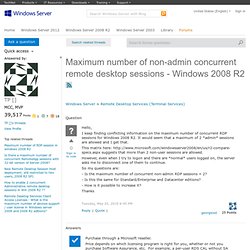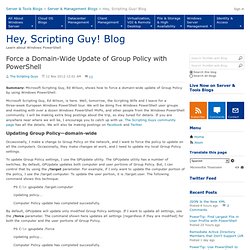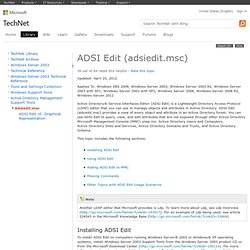

Maximum number of non-admin concurrent remote desktop sessions - Windows 2008 R2. Hi, With the RDS Role and RDSH Role Service installed, the maximum number of non-admin concurrent connections is limited by your available server resources (cpu, ram, io capacity, network bandwidth).

Depending on the applications being run and your server specs you could have hundreds of sessions logged on at the same time. Here is a quick checklist to enable more than two sessions: 1. Add Remote Desktop Services Role using Server Manager, also add Remote Desktop Session Host and RD Licensing role services, set your Licensing mode to either Per User or Per Device, depending on the type of RDS CALs you have purchased (hint: you need to purchase a RDS CAL for each unique user or device that will connect) 2. 3. 4. 5. 6. 7.
Thanks. Force a Domain-Wide Update of Group Policy with PowerShell - Hey, Scripting Guy! Blog. Summary: Microsoft Scripting Guy, Ed Wilson, shows how to force a domain-wide update of Group Policy by using Windows PowerShell.

Microsoft Scripting Guy, Ed Wilson, is here. Well, tomorrow, the Scripting Wife and I leave for a three-week European Windows PowerShell tour. We will be doing five Windows PowerShell user groups and meeting with over a dozen Windows PowerShell MVPs, and other people from the Windows PowerShell community. I will be making extra blog postings about the trip, so stay tuned for details. If you are anywhere near where we will be, I encourage you to catch up with us. Updating Group Policy—domain-wide Occasionally, I make a change to Group Policy on the network, and I want to force the policy to update on all the computers. To update Group Policy settings, I use the GPUpdate utility. PS C:\> gpupdate /target:computer Updating policy... Computer Policy update has completed successfully.
By default, GPUpdate will update only modified Group Policy settings. Adsiedit: Active Directory. Active Directory® Service Interfaces Editor (ADSI Edit) is a Lightweight Directory Access Protocol (LDAP) editor that you can use to manage objects and attributes in Active Directory.

ADSI Edit (adsiedit.msc) provides a view of every object and attribute in an Active Directory forest. You can use ADSI Edit to query, view, and edit attributes that are not exposed through other Active Directory Microsoft Management Console (MMC) snap-ins: Active Directory Users and Computers, Active Directory Sites and Services, Active Directory Domains and Trusts, and Active Directory Schema. This topic includes the following sections: Installing ADSI Edit To install ADSI Edit on computers running Windows Server® 2003 or Windows® XP operating systems, install Windows Server 2003 Support Tools from the Windows Server 2003 product CD or from the Microsoft Download Center ( For more information about how to install Windows Support Tools from the product CD, see Install Windows Support Tools ( Using ADSI Edit. Group Policy. Blog - Converting a Physical Machine to a Hyper-V Virtual Machine (P2V)
Planning for Remote Server Management: System Reliability. Updated: March 28, 2003 Applies To: Windows Server 2003, Windows Server 2003 R2, Windows Server 2003 with SP1, Windows Server 2003 with SP2 Before you deploy servers running the Microsoft® Windows® Server 2003 operating system, determine the extent to which system administrators need to manage them remotely.

If you need to perform only typical administrative tasks over the network, conventional tools suffice. For remotely administered servers — those having no keyboard, video display, or mouse — or for any servers having high availability requirements, you might need to use Emergency Management Services, possibly in conjunction with other hardware and software components, to remotely bring servers back into service even when they are not accessible by means of the standard network connection.
In This Chapter Related Information.